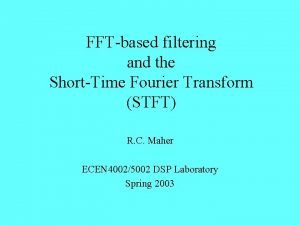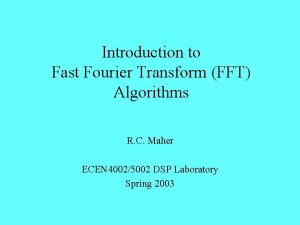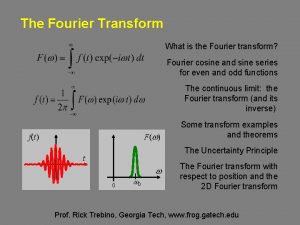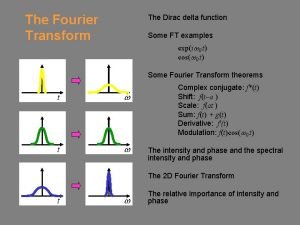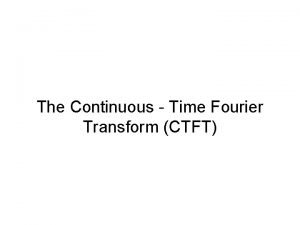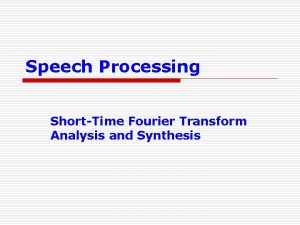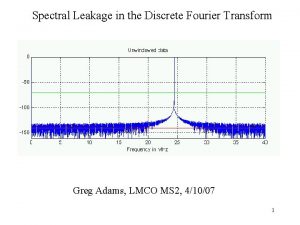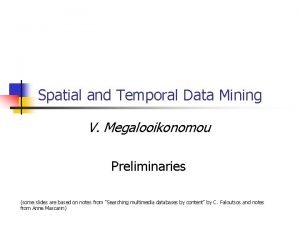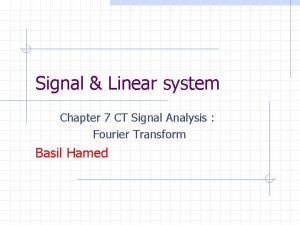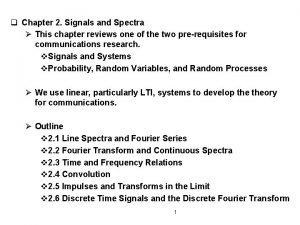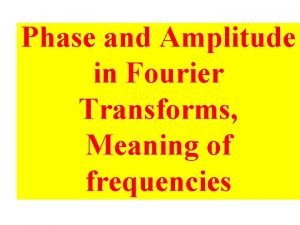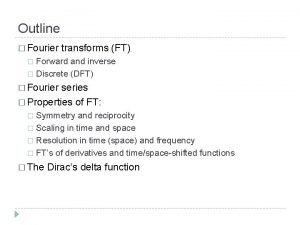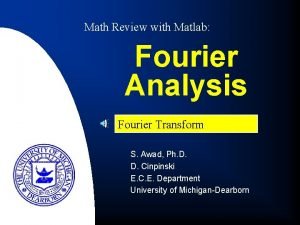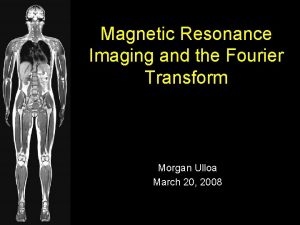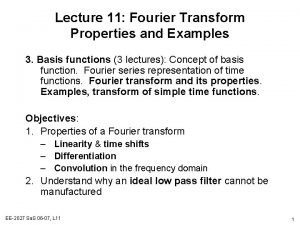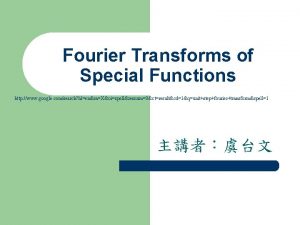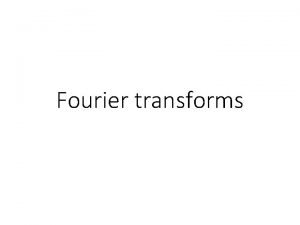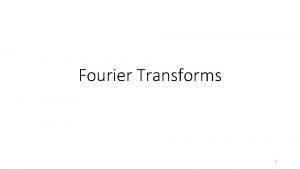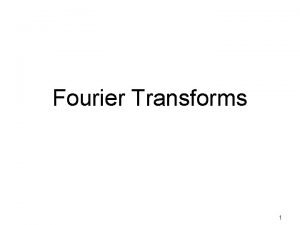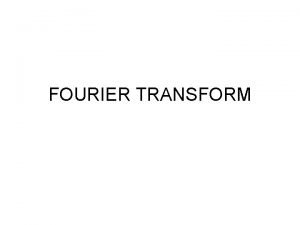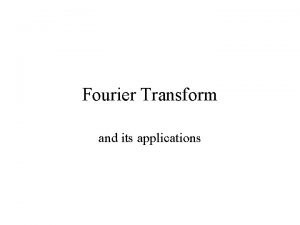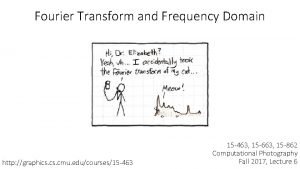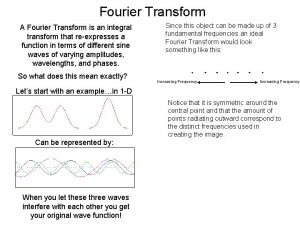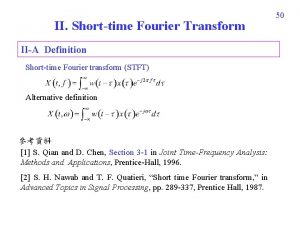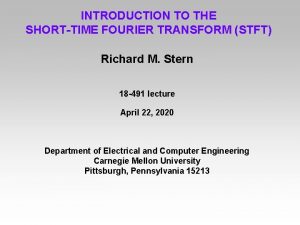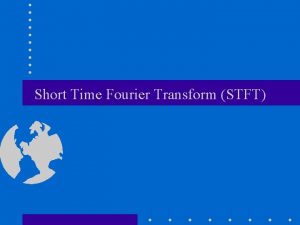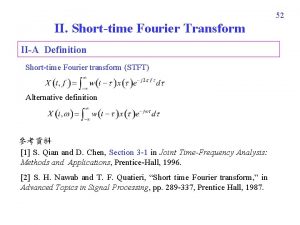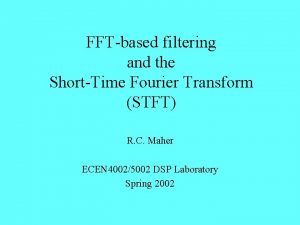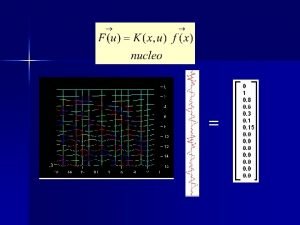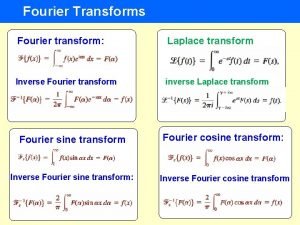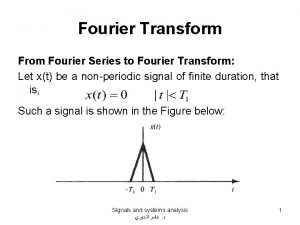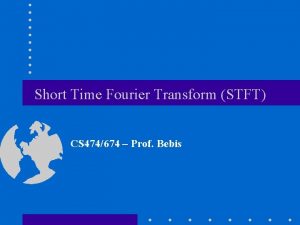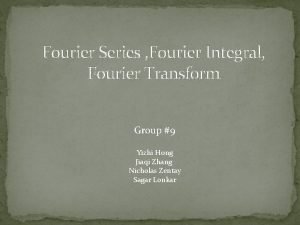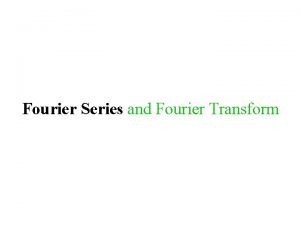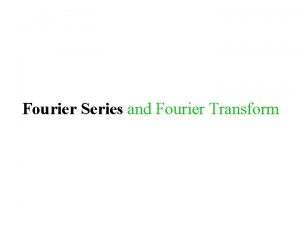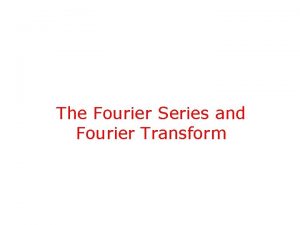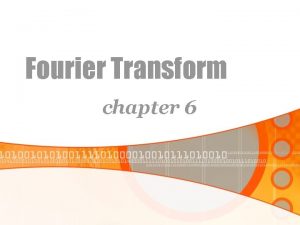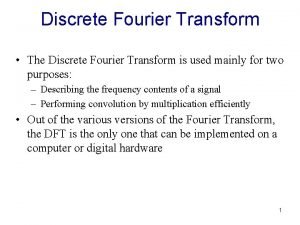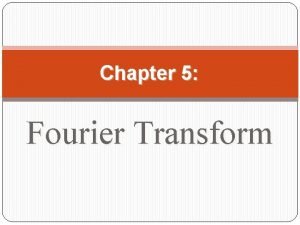INTRODUCTION TO THE SHORTTIME FOURIER TRANSFORM STFT Richard























- Slides: 23

INTRODUCTION TO THE SHORT-TIME FOURIER TRANSFORM (STFT) Richard M. Stern 18 -491 lecture April 22, 2020 Department of Electrical and Computer Engineering Carnegie Mellon University Pittsburgh, Pennsylvania 15213

Why consider short-time Fourier transforms? n Conventional DTFT sums over all time: n An example: “Welcome to DSP-I” n The DTFT averages frequency components over time – (from the creation of the universe until ? ? ? } Slide 2 ECE and LTI Robust Speech Group

“Welcome to DSP-I” in time and frequency Slide 3 ECE and LTI Robust Speech Group

Why we want the STFT … n We are more interested in how the frequency components of real sounds like speech and music vary over time n Example: the spectrogram of “Welcome to DSP-I” Slide 4 ECE and LTI Robust Speech Group

The direct (Fourier transform) approach to STFTs n Multiply the time function and by a sliding window, and take the DTFT of the product: n Comments: – Note that m is a dummy variable and that the window is time-reversed » Notation is consistent with chapter by Nawab and Quatieri in book edited by Lim and Oppenheim; OSPY notation is a little different – Results are plotted as a vector function of n, which is called the index of the analysis frame – Windows most commonly used are Hamming, rectangular, and exponential Slide 5 ECE and LTI Robust Speech Group

An example with exponential windowing Slide 6 ECE and LTI Robust Speech Group

Impact of window size and shape n The DTFT of the window is n Letting l = m–n and m = n–l, we obtain n Hence … n The STFT can be thought of as the circular convolution in frequency of the DTFT of x[m] with the DTFT of w[n–m] Slide 7 ECE and LTI Robust Speech Group

Effect of window duration n The window duration mediates the tradeoff between resolution in time and frequency: n Short-duration window: Long-Duration window: n Best choice of window duration depends on the application Slide 8 ECE and LTI Robust Speech Group

Can the STFT be inverted? n Yes, but …. n Consider the STFT as the transform of the windowed time function: n For n=m we can write n Or, of course n So the only absolute constraint for inversion is Slide 9 ECE and LTI Robust Speech Group

The discrete STFT n Normally we would like the STFT to be discrete in frequency as well as time (for practical reasons) n We use which is evaluated at Slide 10 ECE and LTI Robust Speech Group

Summary: the Fourier transform implementation of the STFT n The Fourier transform implementation of the STFT: – Window input function – Take Fourier transform – Repeat, after shifting window Slide 11 ECE and LTI Robust Speech Group

There are other ways of computing the STFT! n Again, the STFT equation is n Rearranging the terms, we obtain the convolution n This can expressed as the lowpass implementation of the STFT: Slide 12 ECE and LTI Robust Speech Group

The lowpass implementation of the STFT n Note that the frequency response of practical windows w[n] is almost invariably that of a lowpass filter n The lowpass implementation translates the spectrum of x[n] to the left by radians and passes through a lowpass filter Slide 13 ECE and LTI Robust Speech Group

The Hamming window as a lowpass filter n The width of the main lobe of a Hamming window is n We will think of it as if it were an ideal LPF with the same bandwidth Spectrum of Hamming window, M = 40 Approximated ideal rectangular spectrum Single-sided BW is 4π/M Slide 14 ECE and LTI Robust Speech Group

Also, the bandpass implementation of the STFT n The original STFT equation remains n Pre-multiplying and post-multiplying by produces n Which can be expressed as the bandpass implementation of the SFFT: Slide 15 ECE and LTI Robust Speech Group

The bandpass implementation of the STFT n The bandpass implementation can be thought of as passing the signal through a (single-channel) bandpass filter and then shifting the output down to “baseband” n All three implementations are mathematically equivalent representations of the STFT n The signal at the output of the BPF has the same magnitude as X[n, k] but different phase Slide 16 ECE and LTI Robust Speech Group

Some additional comments on implementations n In the Fourier transform implementation will develop the STFT on a column-by-column (or time frame by time frame) basis n In the LP and BP implementations we work on a row-by-row (or frequency-by-frequency) basis n Because the STFT is lowpass in nature, it can be downsampled. The downsampling ratio depends on the size and shape of the window. Slide 17 ECE and LTI Robust Speech Group

Reconstructing the time function n Two major methods used: – Filterbank summation (FBS), based on LP and BP implementations – Overlap-add (OLA), based on the Fourier transform implementation Slide 18 ECE and LTI Robust Speech Group

Reconstructing the time function using FBS Filterbank summation: • Multiply each channel by • Add channels together and multiply by a constant • This will work if all filters add to a constant in frequency Slide 19 ECE and LTI Robust Speech Group

The overlap-add (OLA) method of reconstruction n Procedure: – Compute the IDTFT for each column of the STFT – Add the IDTFTs together in the locations of the original window locations n The OLA resynthesis approach will work if all of the windows add up to a constant. Two (of many) solutions: – Abutting rectangular windows – Hamming windows spaced by 50% of their length Slide 20 ECE and LTI Robust Speech Group

How many numbers do we need to keep? n The answer depends on the method used for analysis and synthesis. n For the Fourier transform STFT analysis with OLA resynthesis: – Need at least N samples in frequency for windows of length N (as is always true for DFTs) – The analysis frames can be separated by N samples for rectangular windows or N/2 samples for Hamming windows – This means that the total number of STFT coefficients per second needed will be NFs/N = Fs for rectangular windows or NFs/(N/2) for Hamming windows n Hence, the STFT requires the same or double the number of numbers in the original waveform. (And these numbers are complex!) We accept this for the benefits that STFTs provide Slide 21 ECE and LTI Robust Speech Group

Summary n Short-time Fourier transforms enable us to analyze how frequency components evolve over time. The most straightforward approach is to window the time function and compute the DFT n The duration of the window mediates temporal versus spectral resolution n The original waveform can be resynthesized from the STFT representation n The number of numbers needed for the representation is somewhat greater, but that is a small price to pay for the ability to analyze and manipulate the input. Slide 22 ECE and LTI Robust Speech Group

 Short time fourier transform
Short time fourier transform R fft
R fft Fourier transform
Fourier transform Fourier transform of dirac delta
Fourier transform of dirac delta By ct ft
By ct ft Short time fft
Short time fft Fourier series
Fourier series Parseval's identity for fourier transform
Parseval's identity for fourier transform Duality of fourier transform
Duality of fourier transform Line spectrum in signals and systems
Line spectrum in signals and systems Phase meaning
Phase meaning Fourier
Fourier Matlab ramp function
Matlab ramp function Frequency
Frequency Fourier transform properties solved examples
Fourier transform properties solved examples Fourier transform of step
Fourier transform of step Difference of gaussian filter
Difference of gaussian filter Fourier transform of 1
Fourier transform of 1 Time shifting fourier transform
Time shifting fourier transform Math review
Math review Properties fourier transform
Properties fourier transform The fourier transform and its applications
The fourier transform and its applications Inverse fourier transform formula
Inverse fourier transform formula Fourier transform of an integral
Fourier transform of an integral
